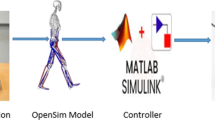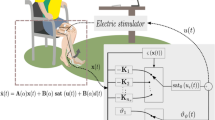Abstract
Biomechanical testing of human musculoskeletal joints not only requires qualified testing machines and devices, but also needs an excellent control method to obtain better experimental results. In this paper, we take the human functional spinal unit (FSU) as an example to study how to improve the performance of the robotic testing system. First, the mechanical characteristics of FSU are described and the simplified model (rigid body–spring system) for the specimen is given. Because the location of the center of rotation (COR) of the specimen affects the performance of the system, a comprehensive analysis on the location of COR is carried out. The performance of the robotic testing system can also be improved through the improvement of the control method. Two control methods have been proposed in this paper: one is the improved hybrid control, the other is fuzzy logic control.
Similar content being viewed by others
REFERENCES
Admas, M., and W. Hutton. The relevance of torsion to the mechanical derangement of the lumbar spine. Spine 6:241–248, 1981.
Bryant, J. T., H. W. Wevers, and P. J. Lowe. One parameter model for error in instantaneous center of rotation measurements. J. Biomech. 17:317–323, 1984.
Challis, J. H. Estimation of the finite center of rotation in planar movements. Med. Eng. Phys. 23:227–233, 2001.
Crawford, N. R., A. G. U. Brantley, C. A. Diclman, and E. J. Koeneman. An apparatus for applying pure nonconstraining moments to spine segments in vitro. Spine 20:2097–2100, 1995.
Crisco, J. J., III, X. Chen, M. M. Panjabi, and S. W. Wolfe. Optimal marker placement for calculating the instantaneous center of rotation. J. Biomech. 27:1183–1187, 1994.
Doehring, T. C. Delineation of In-Vitro Lumbar Spine Structural Properties Using a Robotic/UFS Testing System with Hybrid Control: Experiments and Analytical Simulations Dissertation. Pittsburgh, PA: University of Pittsburgh, 2000.
Edwaeds, W. T., W. C. Hayes, and J. Posner. Variation of lumbar spine stiffness with load. J. Biomech. Eng. 109:35–41, 1987.
Gilbertson, L. G., T. C. Doehring, and J. D. Kang. New methods to study lumbar spine biomechanics: Delineation of in vitro load-displacement characteristics by using a robotic/UFS testing system with hybrid control. Oper. Tech. Orthop. 10:246–253, 2000.
Gilbertson, L. G., T. C. Doehring, G. A. Livesay, T. W. Rudy, J. D. Kang, and S. L.-Y. Woo. Improvement of accuracy in a high-capacity, six degree-of-freedom load cell: Application to robotic testing of musculoskeletal joints. Annu. Biomed. Eng. 27:839–843, 1999.
Goel, V. K., T. A. Nye, C. R. Clark, K. Nishiyama, and J. Weinstein. A technique to evaluate an internal spinal device by use of the selspot system: An application to luque closed loop. Spine 12:150–159, 1987.
Goel, V. K., D. G. Wilder, M. H. Pope, and W. T. Edwards. Controversy: Biomechanical testing of the spine load-controlled versus displacement controlled analysis. Spine 20:2354–2357, 1995.
Halvorsen, K., M. Lesser, and A. Lundberg. A new method for estimating the axis of rotation and the center of rotation. J. Biomech. 32:1221–1227, 1999.
Hunt, K. J., M. Munih, and N. de Donaldson. Feedback control of unsupported standing in paraplegia. Part I: Optimal control approach. IEEE Trans. Rehabil. Eng. 5:331–340, 1997.
Kruse, R., J. Gebhardt, and F. Klawonn. Foundations of Fuzzy Systems. New York: Wiley, 1994.
Kumar, N., S. Kukreti, M. Ishaque, D. K. Sengupta, and R. C. Mulholland. Functional anatomy of the deer spine: An appropriate biomechanical model for the human spine. Anat. Rec. 266:108–117, 2002.
Kunz, D. N., R. P. McCabe, T. A. Zdeblick, and R. Jr. Vanderby. A multi-degree of freedom system for biomechanical testing. J. Biomech. Eng. 116:371–373, 1994.
Moeini, S. M., J. E. Lemons, M. J. McCutcheon, and F. J. Molz. Investigation of video techniques for dynamic measurements of relative vertebral-body motion in vitro. Biomed. Instrum. Tech. 30:62–70, 1996.
Norton, H. N. Handbook of Transducers. Englewood Cliffs, NJ: Prentice-Hall Inc., 1989.
Panjabi, M. M., R. A. Brand, and A. A. White. Mechanical properties of the human thoracic spine as shown by three-dimensional load-displacement curves. J. Bone Joint Surg. Am. 58:642–652, 1976.
Patwardhan, A. G., R. M. Havey, K. P. Meade, B. Lee, and B. Dunlap. A follower load increases the load-carrying capacity of the lumbar spine in compression. Spine 24:1003–1009, 1999.
Patyra, M. J., and D. M. Mlynek. Fuzzy Logic Implementation and Applications. New York: Wiley, 1996.
Petroff, N., K. D. Reisinger, and P. A. C. Mason. Fuzzy-control of a hand orthosis for restoring tip pinch, lateral pinch, and cylindrical prehensions to patients with elbow flexion intact. IEEE Trans. Neural Syst. Rehabil. Eng. 9:225–231, 2001.
Riess, J., and J. J. Abbas. Adaptive control of cyclic movements as muscles fatigue using functional neuromuscular stimulation. IEEE Trans. Neural Syst. Rehabil. Eng. 9:326–330, 2001.
Riess, J., and J. J. Abbas. Adaptive neural network control of cyclic movements using functional neuromuscular stimulation. IEEE Trans. Rehabil. Eng. 8:42–52, 2000.
Spiegelman, J. J., and S. L.-Y. Woo, A rigid-body method for finding centers of rotation and angular displacements of planar joint motion. J. Biomech. 20:715–721, 1987.
Spour, C. W., and F. E. Veldpaus. Rigid body motion calculation from spatial coordinates of markers. J. Biomech. 13:391–393, 1980.
Veldpaus, F. E., H. J. Woltring, and L. J. M. G. Dortmans. A least-squares algorithm for the equation transformation from spatial marker coordinates. J. Biomech. 21:45–54, 1988.
Yen, J., R. Langari, and L. A. Zadeh. Industrial Applications of Fuzzy Logic and Intelligent Systems. New York: The Institute of Electrical and Electronics Engineers, Inc., 1995.
Author information
Authors and Affiliations
Rights and permissions
About this article
Cite this article
Tian, L. Control Methods and the Performance of the Robotic Testing System for Human Musculoskeletal Joints. Annals of Biomedical Engineering 32, 889–898 (2004). https://doi.org/10.1023/B:ABME.0000030264.30498.5d
Issue Date:
DOI: https://doi.org/10.1023/B:ABME.0000030264.30498.5d




